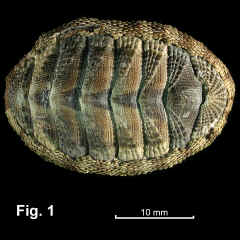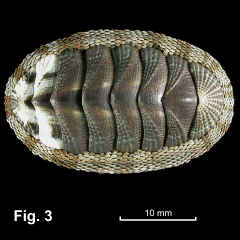|
|
CHITONIDAE |
|
|
|
Sypharochiton pelliserpentis (Quoy & Gaimard, 1835) Description: Animal broadly ovate, low, rounded dorsally, girdle narrow, valve surface usually eroded. Median valves, when not eroded, with lateral and pleural areas distinct; lateral areas with 3-5 nodulose radial ribs; pleural area with longitudinal riblets, weak on jugum. Girdle covered with large, smooth scales, up to 1 mm in width. Valve colour variable; grey, dark brown or black, sometimes with a dark band along dorsum; occasionally 1 or 2 valves white. Size: In NSW, up to 42 mm in length, but up to 63 mm in Tas. Distribution: Australia and New Zealand. In Australia, from Port Stephens southwards to Mallacoota, eastern Vic, and all the Tasmanian coast. Habitat: Common on the upper surface of rocks above mid-tide level, usually in crevices or depressions. Less frequently found as juveniles under stones below mid-tide level. Comparison: The large scales and location on the shore identify this species. Synonymy: This has been known as Sypharochiton septentriones Ashby, 1924, and the Tasmanian population as Sypharochiton maugeanus Iredale & May, 1916. Remarks: Iredale & Hull (1927, p. 120) gave the range in NSW as southwards to Montage Island, and absent from Jervis Bay. But subsequent collecting has found the species occurs in Jervis Bay, and extends southwards to Mallacoota in Victoria. Fig. 1: Kirribilli Point, Port Jackson, NSW (C.044864). Fig. 2: Girdle detail. Same specimen as Fig. 1. Fig. 3: Long Reef, Collaroy, NSW (C.563323). |
|


